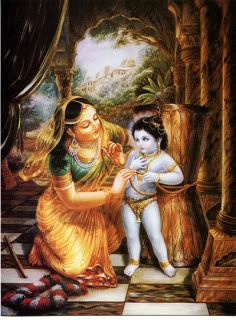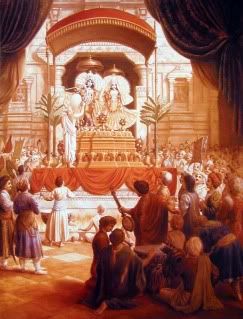By Karnamrita Das
[Reposted from 10-11-2011]One of the recommendations for advancing in devotional service is the observance of Kartika Vrata (special devotional practices) especially in Vrindavana, India, or at some holy place, but anywhere that we worship Krishna during the Vedic month of Kartika, or Damodara, which corresponds to October-November. It began yesterday on the full moon and continues to the following full moon. As the next month of Margashirsha represents Krishna, [Bg 10.35] this month represents Shri Radha, who is the feminine compassionate aspect of Krishna. Shri Radha is considered the best devotee of Krishna, and she is both Deity and ideal of devotion for Gaudiya Vaishnavas. We try to please Radha, and our gurus who represent her, to obtain the favor of Krishna, which means engaging in His devotional service eternally. Our aim is not so much to obtain Krishna, but love of Krishna, or prema, because wherever prema exists, Krishna lives! Thus by the grace of the Divine Couple, Shri Radha and Krishna, Radha’s month is considered like a special sale, where the ordinarily very difficult ideal of pure devotion, becomes easily available for a small price. Ours is truly a path of mercy, though as much as possible we also follow the recommendations in the scriptures for our daily spiritual practices.
Although sometimes devotee perform certain austerities like eating or sleeping less, such things should only be done to facilitate the practice of any of the nine main types of devotional service: “Prahlada Maharaja said: ‘Hearing and chanting about the transcendental holy name, form, qualities, paraphernalia and pastimes of Lord Vishnu, remembering them, serving the lotus feet of the Lord, offering the Lord respectful worship with sixteen types of paraphernalia, offering prayers to the Lord, becoming His servant, considering the Lord one's best friend, and surrendering everything unto Him (in other words, serving Him with the body, mind and words) -- these nine processes are accepted as pure devotional service. One who has dedicated his life to the service of Krishna through these nine methods should be understood to be the most learned person, for he has acquired complete knowledge.’” [ Shrimad Bhagavatam 7.5.23-24]
We are not jnanis or Vedic philosophers whose main item of spiritual advancement is performing austerities and speculating on the scriptures, but we are aspiring devotees of Krishna, or bhakti yogis, whose main spiritual practices are based on the above nine methods of devotional service. Therefore any vows we take during this special month should be based on the direct limbs of bhakti. In a similar way to this month, fasting is recommended for the bi-monthly observance of Ekadashi, but the most important item to be done on that day is increased remembrance of Krishna, and increased practice of devotional service. Otherwise, merely performing austerities with no increase of service to Krishna, makes the heart harder.
Our goal is to love Krishna, not to be austere for the sake of austerity, as do some yogis or jnanis. Everything comes to us in relationship to our love for Krishna and service attitude towards Him. By attachment to Krishna, we become naturally detached to anything which doesn’t facilitate our devotional service.
We learn that the six Goswamis of Vrindavana, the principle disciples of Lord Chaitanya, hardly ate or slept. However, these external restrictions of their activities for bodily maintenance were a by-product of their love for Krishna, not their means of obtaining Krishna. When we engage in devotional service we automatically restrict our actions, which can be taken as a natural austerity in relationship to Krishna’s service.
If we only eat food offered to Krishna, this means only offering Krishna food from food groups he requests. This automatically excludes our eating meat, fish, eggs, and even onions and garlic. Thus eating, or honoring, Prasad (sanctified food which is edible mercy), is an automatic austerity. Further austerities are an individual practice. Some may find that limiting their eating, or sleeping less during Kartika may facilitate their increased absorption in devotional practices, while others may be more hungry and tired and not necessarily more conscious of Krishna! In a nutshell, we do what is favorable for bhakti, and avoid what isn’t, and this should also be our guide during this month. We have to find a balance between stretching ourselves in order to grow spiritually and avoiding doing too much, which may be counterproductive.
Much depends on your spiritual advancement and how long you have been an aspiring devotee of Krishna. Newcomers (or anyone) may want to go to bed earlier and rise earlier so that they can chant and read before they go to work. Or they may decide to exclude eating certain foods that are not offerable to Krishna, with the hope and prayer that this will become their lifelong practice. We can also read, or reread the Bhagavad Gita As It Is, and/or such books as Nectar of Devotion, Teachings of Lord Chaitanya, etc for 15 or 20 minutes a day. Such reading gives us a taste of the nectar of such literature, and by appreciating the greatness and sweetness of Krishna our desire for devotional practices increases. These are examples of natural austerities one can do during Kartika that are favorable for Bhakti, and pleasing to Krishna.
One of the recommended activities during Kartika is the singing of the devotional song, Shri Damodarashtaka, which recounts the intensity of love expressed by Krishna’s mother Yashoda. [Here are the verses and translations: http://www.celebratekrishna.com/index.php?option=com_content&view=article&id=49&Itemid=65] During this ceremony we also offer Krishna a candle or ghee wick and think of offering ourselves to Him as well. Singing these prayers, studying the meaning, and also this pastime of Krishna being bound to the grinding mortar in the Tenth Canto of Shrimad Bhagavatam or Krishna Book, is pleasing to Krishna. By doing so, we learn the super excellent standard of pure devotion, and its superiority to reverential, official worship. Although great yogis try to capture Krishna in his form as Vishnu within their heart, Krishna can only be captured, or as illustrated in this pastime, caught and tied up, through the power of love.
In the verses surrounding his Shikshastakam prayers in the scripture Chaitanya Charitamrita, Shri Chaitanya teaches us that the many forms and names of God correspond to the intensity of love for Krishna. Krishna is that form of God which corresponds to the highest and purest love. Krishna consciousness, or the path of shuddha (pure) bhakti, is the path of understanding the most exalted and unadulterated pure standard of devotional service to Krishna, and learning to follow those who teach this standard of worship and love. The persons described in Shrimad Bhagavatam are our teachers and mentors, not fictitious persons, and we are meant to follow in their footsteps according to our developed spirituality, under the guidance of pure devotees. Let us all increase our devotional activities in this month and thus pray to further our attraction and love for Krishna by the grace of Shri Radha and those who represent them!
Source: http://www.krishna.com/blog/2011/10/3/month-kartika%E2%80%94pure-devotion-sale-less




Comments